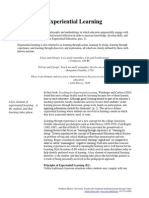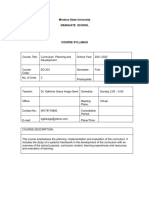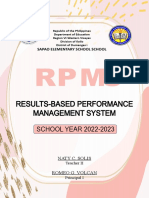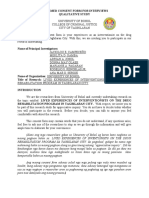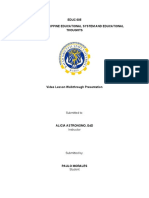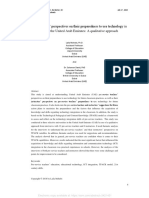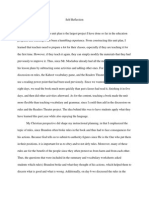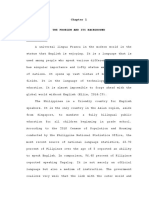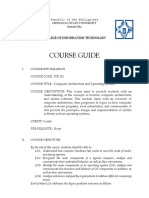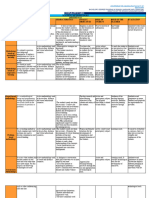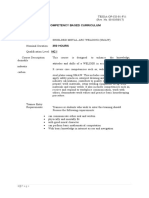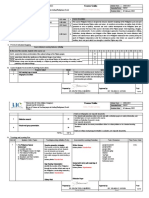Professional Documents
Culture Documents
Effectiveness of Flexible Learning On The Academic Performance of Students
Original Title
Copyright
Available Formats
Share this document
Did you find this document useful?
Is this content inappropriate?
Report this DocumentCopyright:
Available Formats
Effectiveness of Flexible Learning On The Academic Performance of Students
Copyright:
Available Formats
Volume 7, Issue 7, July – 2022 International Journal of Innovative Science and Research Technology
ISSN No:-2456-2165
Effectiveness of Flexible Learning on the Academic
Performance of Students
Elisa F. Grampil
Philippine State College of Aeronautics, Pasay City, Philippines
Abstract:- The study was undertaken to assess the the internet connection issues, no proper preparation and the
effectiveness of flexible learning on the academic lack of equipment needed would lead to poor effectiveness that
performance of the students in aviation electronics may hinder the development of the students’ academic
technology in Philippine State College of Aeronautics. The performance. Whereas the other starts to believe that modern
goal was to determine the significant difference on the level of education will arise soon because of its benefits.
academic performance of the students between the
traditional and flexible learning and to determine if there is Purpose
a significant difference on the characteristics of the learning The study is primarily focused on the effectiveness of
tool they used. The findings of the study showed that there flexible learning on the academic performance of the students
is a significant difference on the academic performance of in Aviation Electronics Technology Batch 2020-2021 in
the students during flexible learning. Their GWA increased Philippine State College of Aeronautics in 2nd Year and 3rd
as opposed to traditional learning. However, there is no Year. The study aims to determine the effectiveness of flexible
significant difference when it comes to the characteristic of learning by analyzing their academic performance during the
the learning tool in thoughtful practice. The students may traditional learning vs. flexible learning and their evaluation on
have out form their GWA, but the internal learning was not the characteristics of the learning tool used in the traditional and
there. flexible.
Keywords:- Flexible Learning, Traditional Learning,
Synchronous, Asynchronous
I. INTRODUCTION
The traditional learning is the accustomed method of
learning and a well- established modality that has been refine
over the years in the Philippines. It is a learning method where
there is a face-to-face interaction of the learning process
between the students and teacher that takes place physically in
a classroom setting. The flexible learning is a form of distance
learning method being offered as the current modality due to
pandemic restrictions, whereas there are no physical face-to-
face interactions between the students and teacher. The learning
process of the student in flexible learning takes place in two
methods: synchronous and asynchronous. The sudden
transition to the new learning set up from being accustomed to
the traditional set up brought a challenge to the pedagogy of
learning of the students to their academic performance. The
objective of the study is to identify the effectiveness of the
flexible learning on the academic performance of the students
with opposed to the traditional learning; as stated in the
instructional design theory, one method may work best in one
situation while another may work best in a different situation.
Schools all over the globe have been closed due to the
outbreak of COVID-19. 1.3 billion students around the world
have been affected by the rapid change of the learning set up,
wherein the students were left with no choice but to adopt the
new learning set up which is the online learning(UNESCO,
2020). The unplanned transition to online learning along with
IJISRT22JUL1078 www.ijisrt.com 1298
Volume 7, Issue 7, July – 2022 International Journal of Innovative Science and Research Technology
ISSN No:-2456-2165
The system approach used is the Flow Chart System in signed letter of consent in a PDF form was sent to the school
describing the conceptual framework of the study. As shown in registrar by the researchers. The researchers received the list
Figure 1, the participants of the study are studied according to of GWA sent by the school registrar in an Excel Form. The
their academic performance in the 2nd semester 2019 secondary data, demographic profile of the participants and
(Traditional) and 1st semester 2020 (Flexible) and their their evaluation on the characteristics of the learning tool used
evaluation on the characteristics of the learning tool used in the in Traditional and Flexible learning was collected through
traditional learning and flexible learning to know on what part survey questionnaire via Google forms. The collected data was
does the learning tools lacking on a specific area. Signed treated with utmost privacy and was used with the solely
consent letters permitting the researchers to collect their data purpose of the research.
through registrar are collected from the participants. After
collecting the consent letters, the letter of request is sent to the III. RESULTS
school registrar to collect the data. The academic performance
of the participants in 2nd semester 2019 and 1st semester in A. The demographic profile of the participants were taken
2020 is then collected from the school registrar. The evaluation according to:
of the participants on the characteristics of the learning tool
used on the clear information, thoughtful practice, informative Year Level
feedback, strong intrinsic, and extrinsic motivation during their Finding shows that there are 50 students (50%) from the
traditional and flexible learning (synchronous and 2nd year level and 50 students (50%) from the 3rd year level.
asynchronous) is considered to find on where the learning tool The total participant of the study is 100 with a percentage of
lack on the effectiveness of the learning process of the 100%.All acquired participants was surveyed and their GWA
participants does the process of collecting the data on this is was collected.
through survey questionnaire.
Gender
Research Questions Finding shows that from the total number of 100
[1]. What is the demographic profile of the students in participants, there are 57 male students with(57%) and 43
Aviation Electronics Technology in terms of: Year Level; female students with (43%). Majority of the participants are
Gender; Age; Residence Location; Socioeconomic dominated by male and least dominated by female.
Status?
[2]. What is the academic performance of the students on 2nd Age
semester 2019 and 1st semester 2020 in terms of: 2.1 Finding shows that from the total number of the
GWA? participants of 100, there are 58 students belongs to the age
[3]. Is there a significant difference on the academic bracket of 21 to 23 (58%); 41 students belong to the age bracket
performance of the students between 2nd semester 2019 of 18 to 20 (41%) and 1 student belongs to the age bracket of
(Traditional) and 1st semester 2020 (Flexible) in terms of: 24 to 26 (1%). Majority age bracket of the participants is 21 to
GWA? 23 and least on 24 to 26.
[4]. What is the characteristics of the learning tool used of the
students in terms of: Residence Location
[5]. Traditional; Synchronous; Asynchronous? Finding shows that from the total number of the
[6]. Is there a significant difference between the characteristics participants of 100, there are 53 students that lives in the Rural
of the learning tool used on academic performance of the (53%); 30 students that live in the Urban (30%) and 17 students
students in terms of: Traditional vs Synchronous; that live in suburban (17%). Majority of the participants lives
[7]. What implications may be drawn from the result of the in the Rural and least on Suburban.
study on the effectiveness of Flexible learning on the
academic performance of the students in terms of: Socioeconomic Status
Instructional Tools; Finding shows that in terms of socioeconomic status there
Instructional Outcomes? are 28 students with 10,000 to 20,000 monthly (28%) followed
by 26 students with 20,000 to 40,000 monthly (26%) and least
II. METHODOLOGY 4 students with 70,000 to 100,000 (4%). Majority of the
participants belongs to the bracket of 10,000 to 20,000 or low-
The method of collecting the primary data is on two parts. income class and least on 70,000 to 100,000 or upper middle
First, the letter of consent was collected from the participants class.
and second, the list of GWA was collected from the school
registrar. The researchers collected the signed letter of consent
from the participants, compiled in it a tabulated form together
with their student ID in a PDF form and a letter of request to
collect the data (GWA) of the participants together with the
IJISRT22JUL1078 www.ijisrt.com 1299
Volume 7, Issue 7, July – 2022 International Journal of Innovative Science and Research Technology
ISSN No:-2456-2165
B. The academic performance of the students on 2nd semester their requirements. There might be a lack of instructors which
2019 and 1st semester 2020 was taken according to: results to work overload for them to handle.
GWA E. The significant relationship between the characteristics of
Finding shows that the academic performance of the 2nd the learning tool used on the academic performance of the
year students in terms of GWA on 2nd semester 2019 or on the students were taken according to:
traditional learning was 2.14 and on 1st semester 2020 or on the
flexible learning was 1.47; 3rd year students in terms of GWA Traditional vs. Synchronous
on 2nd semester 2019 or on the traditional learning was 1.47 There was a significant difference on their mean for the
and on 1st semester 2020 or on the flexible learning was 1.37. given categories in the learning such as the clear information,
thoughtful practice, information feedback, intrinsic and
C. The significant difference on the academic performance of extrinsic motivation with a mean difference of .533, .327, .420,
the students on 2nd semester 2019 and 1st semester 2020 .780 and .435 respectively. It also shows that the mean of the
was taken according to: traditional learning has a greater mean against the synchronous
learning. Both traditional and synchronous has a visual and real
GWA time interaction that helps the student on their learning process.
Finding shows that there is a significant difference on the The differences are on the part of physical interaction and
academic performance of the students for both year levels in the online interaction between the students and the instructors.
flexible learning with mean of 0.67 and 0.10. The learning
outcome of the participants or the GWA in the flexible learning Traditional vs. Asynchronous
has found an increase as opposed to the traditional learning There was a significant difference on their mean for the
outcome. given categories in the learning such as the clear information,
informative feedback, intrinsic and extrinsic motivation with a
D. The characteristics of the learning tool used of the students mean difference of .573, .790, .790, and .365 respectively. It
were taken according to: also shows that the mean of the traditional learning has a greater
mean against the asynchronous learning. While in terms of the
Traditional thoughtful practice, there was no significant difference on the
Finding shows that the characteristics of the learning tool mean for the traditional and asynchronous learning. The
used in the traditional was attained in terms of clear information thoughtful practice was found no significant difference as the
with mean of 3.31; thoughtful practice with mean of 3.36; modules contains activities on the last part of the lesson.
informative feedback with mean of 3.20; intrinsic motivation
with mean of 3.75; extrinsic motivation with mean of 3.71.The F. The implications drawn from the result of the study on the
traditional has attained the characteristics of an effective effectiveness of Flexible learning on the academic
learning tool as it was the accustomed and well-shaped learning performance of the students in terms of:
modality.
Instructional Tools
Synchronous Flexible learning can be prolonged due to the intermittent
Finding shows that the characteristics of the learning tool condition or situation of the Philippines, school/instructors
used in the synchronous was attained in terms of clear should maintain the current quality and only improve the virtual
information with mean of 2.78; thoughtful practice with mean laboratory activities for the learning process of the students.
of 3.03; informative feedback with mean of 2.78; intrinsic
motivation with mean of 2.97; extrinsic motivation with mean Instructional Outcomes
of 3.27. The synchronous has attained the characteristics of an Since, the effectiveness of flexible learning has been
effective learning tool as it has real time interaction the student, proved; school/instructors should look upon further on finding
like traditional by virtually. if the students really understand well the lesson such as
improving of the students especially on laboratory activities
Asynchronous that can be found as the main lacking needs of the students due
Finding shows that the characteristics of the learning tool to the pandemic limitations.
used in the traditional was attained in terms of clear information
with mean of 2.74; thoughtful practice with mean of 3.38;
intrinsic motivation with mean of 2.96; extrinsic motivation
with mean of 3.34. The informative feedback was not attained
with mean of 2.41. The asynchronous has not attained the
informative feedback on the characteristics of an effective
learning tool as the instructors might be late in releasing the
grades of the students or the students might be late in passing
IJISRT22JUL1078 www.ijisrt.com 1300
Volume 7, Issue 7, July – 2022 International Journal of Innovative Science and Research Technology
ISSN No:-2456-2165
IV. CONCLUSION REFERENCES
Based on the indicated findings, the following conclusions [1]. Blake, C. (2021, January 3). Resilient Educator. Retrieved
were drawn: July 2, 2021, from Cultivating Motivation: How to Help
Students Love Learning:
The flexible learning has a significant difference on the https://resilienteducator.com/classroom-
academic performance of the 2nd year and 3rd year students resources/cultivating-student- motivation/
in Aviation Electronics Technology in Philippine State [2]. Brown, B., Schroeder, M., & Eaton, S. (2016). Institute of
College of Aeronautics. The GWA of the students during Education Sciences. Retrieved July 2, 2021, from
the flexible learning was higher as opposed to traditional Designing Synchronous Online Interactions and
learning. Discussions:
https://files.eric.ed.gov/fulltext/ED573166.pdf
The learning tools characteristics in terms of clear [3]. [3] Buenaventura, R. D., Ho, J. B., & Lapid, M. I. (2020,
information, thoughtful practice informative feedback, April 30). Cambridge University Press. Retrieved June
intrinsic and extrinsic motivation has a significant 20, 2021, from COVID-19 and mental health of older
difference on the academic performance in traditional and adults in the Philippines: a perspective from a developing
synchronous of the students. However, in terms of the country:
thoughtful practice on asynchronous, there was no https://www.cambridge.org/core/journals/international-
significant difference on the mean for the traditional and psychogeriatrics/article/covid19-and-mental-health-of-
asynchronous learning. The students might have higher older-adults-in-the- philippines-a-perspective-from-a-
GWA on the flexible learning but do not really developing-
understand/learn well as opposed to traditional learning that country/CE99711179336AD47C3BDA6C981BEAB4?fb
they might have lower GWA, but they do really clid=IwAR2AOC9k p9kYuqvTpP6lLhOLbR17tV2nX
understand/learn the lesson. [4]. Calhoun, C., Sahay, S., & Wilson, M. (2020). Design for
Learning. Retrieved May 4, 2021, from Instructional
RECOMMENDATION Design Evaluation:
https://edtechbooks.org/id/instructional_design_evaluatio
The effectiveness of flexible learning on the academic n
performance of the students was revealed. Thus, the following [5]. CHED. (2020, May 21). Retrieved May 3, 2021, from
recommendations are hereby presented: Guidelines on the Implementation of Flexible Learning:
https://ched.gov.ph/wp- content/uploads/CMO-No.-4-s.-
In terms of not attaining the informative feedback in the 2020-Guidelines-on-the-Implementation- of-Flexible-
asynchronous, the researchers recommend the future Learning.pdf
researcher interested to conduct a study on where the [6]. Culatta, R. (2018, May 11). Instructional Design.
discrepancy exists between the students and the instructors. Retrieved May 19, 2021, from History of Instructional
The informative feedback may not be attained due to the late Design: During World War II, when the US military
releasing of grades by the instructors but also it may not be needed to quickly train vast numbers of people to perform
attained due to the late submissions of the requirements by complex technological tasks, the groundwork for
the students. There might be also a shortage in instructors to instructional design was laid (Culatta
handle the class efficiently as there might be a work [7]. Delas Peñas, E. (2020, August 19). SDSN Youth.
overload to the instructors. Retrieved April 30, 2021, from Challenges of Online
Learning vs Traditional Learning for Students:
The basis of this study was based on the GWA of the https://covid19.sdsnyouthph.org/article.php?id=51
students by general. The researchers recommend to the [8]. Domingo, K. (2020, September 17). ABS-CBN News.
future researchers interested in continuing this study to Retrieved July 1, 2021, from Who are identified rich,
modify further the learning outcome of the students by their poor? Gov't shows income class brackets in PH:
academic performance in terms of examination, quizzes, https://news.abs-cbn.com/news/09/17/20/who-are-
activities etc. as the discrepancy can also be seen in these identified-rich-poor- govt-shows-income-class-brackets-
parts to further modify the effectiveness. in-ph
[9]. Finol, M. O. (2020, March 26). Bryn Mawr College.
Retrieved May 3, 2021, from Asynchronous vs.
Synchronous Learning: A Quick Overview:
https://www.brynmawr.edu/blendedlearning/asynchrono
us-vs- synchronous-learning-quick-overview
IJISRT22JUL1078 www.ijisrt.com 1301
Volume 7, Issue 7, July – 2022 International Journal of Innovative Science and Research Technology
ISSN No:-2456-2165
[10]. Ibyatova, L., Oparina, K., & Rakova, E. (2018, May 25). Retrieved May 30, 2021, from
Modular Approach to Teaching and Learning English https://thesai.org/Downloads/Volume11No12/Paper_12-
Grammar in Technical Universities. The_Effectiveness_of_Adopting_e_Learning.pdf
[11]. Proceedings of the International Scientific Conference, I, [20]. Parajuli, M., & Thapa, A. (2017). Gender Differences in
11. Retrieved July 2, 2021, from the Academic Performance of Students. Journal of
https://www.researchgate.net/publication/325368627_M Development and Social Engineering, 9. Retrieved July 1,
ODULAR_APPRO 2021, from
ACH_TO_TEACHING_AND_LEARNING_ENGLISH https://journals.sagepub.com/doi/abs/10.1177/014920630
_GRAMMAR_IN_TEC HNICAL_UNIVERSITIES 202800504?jour nalCode=joma
[12]. Kent State University. (2021, June 28). Retrieved July 1, [21]. Paul, J., & Jefferson, F. (2019, November 12). A
2021, from SPSS TUTORIALS: PAIRED SAMPLES T Comparative Analysis of Student Performance in an
TEST: Online vs. Face-to-Face Environmental Science Course
https://libguides.library.kent.edu/SPSS/PairedSamplestT From 2009 to 2016. Original Research, 9.
est doi:10.3389/fcomp.2019.00007
[13]. Laguador, J. (2021, August 8). Challenges Encountered [22]. Perkins, D. N. (1992). Smart schools : better thinking and
during Pandemic in Flexible Learning Among College learning for every child. New York: The Free Press.
Students Living in Urban, Rural, and Suburban Areas in Retrieved May 4, 2021
the Philippines. Asia Pacific Journal of Educational [23]. Rahman, I., Kabir, R., & Al-Bashir, M. (2016). The Value
Perspectives, 8(1), 10. Retrieved May 30, 2021, from and Effectiveness of Feedback in Improving Students’.
https://d1wqtxts1xzle7.cloudfront.net/66286591/APJEA Journal of Education and Practice, 4. Retrieved July 2,
S_2021.8.1.02- with-cover-page- 2021, from
v2.pdf?Expires=1626019663&Signature=E441rZ9TTzD https://files.eric.ed.gov/fulltext/EJ1105282.pdf
0DbTVl7lINsNeUk [24]. Reigeluth, C. M. (1999). Instructional Design Theory
hPgnX8uUs2SN12Jydiopck0q5TthRILlH0cwaJzNa9nlk (Vol. II). Mahwah, New Jersey: Lawrence Erlbaum
GzW58RgRIEP1a7 Associates, Inc., Publishers. Retrieved May 20, 2021,
shsseRWt4kTmRlP5iyM8MdSxQ0L2UemMO59i3qbgi from
XcQHfWCKAep https://books.google.com.ph/books?hl=en&lr=&id=OUq5
[14]. Markovic, I. (2020, September 30). Edume. Retrieved 5prZIMEC&oi=fnd
from Why Giving Instant Feedback is Important for &pg=PT18&dq=instructional+design+theory&ots=1MvB
Effective Learning: https://edume.com/blog/role- of- SGUskv&sig=u6kd
feedback-in-improving-learning SfMIpd06hOrCSA7fokH4iZk&redir_esc=y#v=onepage
[15]. Mathewson, T. G. (2019, March 27). The Hechinger &q&f=false
Report. Retrieved July 2, 2021, from How to unlock [25]. Rohani, L., & Francescucci, A. (2018, December 13).
students’ internal drive for learning: Exclusively Synchronous Online (VIRI) Learning: The
https://hechingerreport.org/intrinsic-motivation-is-key- Impact on Student Performance and Engagement
to-student- achievement-but-schools-kill-it/ Outcomes. Journal of Marketing Education, 16. Retrieved
[16]. Mehrbach, L., & Beingessner, C. (2018, August 8). July 2, 2021, from
Getting Smart. Retrieved July 1, 2021, from Why Flexible [26]. https://journals.sagepub.com/doi/full/10.1177/027347531
Learning Environments?: 8818864?fbclid=IwAR1a
https://www.gettingsmart.com/2018/08/why-flexible- i3kJQuut9Quz_LvLcu7lwkPxVl9iYpdhMcNjZ42ITjLLv
learning- environments/ ZdBSpoUCNs
[17]. Meşe, E., & Sevilen, Ç. (2021). Factors influencing EFL [27]. Scheiderer, J. (2021, March 24). The Ohio State
students’ motivation in online learning: A qualitative . University. Retrieved May 3, 2021, from What's the
Journal of Educational Technology and Online Learning, Difference Between Asynchronous and Synchronous
12. Retrieved July 2, 2021, from Learning?: https://online.osu.edu/resources/learn/whats-
https://files.eric.ed.gov/fulltext/EJ1286748.pdf difference-between-asynchronous-and-synchronous-
[18]. Neubauer, A. B., Smyth, J. M., & Sliwinski, M. J. (2019, learning
January 1). The Journals of Gerontology. Retrieved July [28]. Shivaramaiah, G. (2018, June 1). Xavier University
1, 2021, from Age Differences in Proactive Coping With School of Medecine. Retrieved July 1, 2021, from
Minor Hassles in Daily Life: Teaching Learning Methods: Traditional vs. Modern vs.
https://academic.oup.com/psychsocgerontology/article/7 Peer-Assisted Learning:
4/1/7/5042148?lo gin=true https://xusom.com/uncategorized/teaching-learning-
[19]. Obeidat, A., Obeidat, R., & Al-Shalabi, M. (2020). The methods-traditional- vs-modern-vs-peer-assisted-
Effectiveness of Adopting e-Learning during COVID-19 learning/
at Hashemite University. International Journal of
Advanced Computer Science and Applications, 11, 9.
IJISRT22JUL1078 www.ijisrt.com 1302
Volume 7, Issue 7, July – 2022 International Journal of Innovative Science and Research Technology
ISSN No:-2456-2165
[29]. Taneja, V. (2020, May 8). India Today. Retrieved July 1,
2021, from What makes traditional learning or offline
learning so important and why it cannot be completely
eliminated?: https://www.indiatoday.in/education-
today/featurephilia/story/traditional-learning-will-
always-have-a-place-in- our-classrooms-1675692-2020-
05-08
[30]. Uenishi, K. (2019, March 27). The Usefulness of Original
Teaching Materials for Motivation.
doi:10.5772/intechopen.85440
[31]. UNESCO. (2020, May 11). Retrieved April 29, 2021,
from Education: From disruption to recovery:
https://en.unesco.org/covid19/educationresponse
[32]. UNESCO. (2020, April 29). UNESCO. Retrieved April
25, 2021, from 1.3 billion learners are still affected by
school or university closures, as educational institutions
start reopening around the world, says UNESCO:
https://en.unesco.org/news/13-billion-learners-are-still-
affected-school- university-closures-educational-
institutions
[33]. Villanueva, M., & Núñez, J. (2020, July 25). Institute of
Education Sciences. Retrieved July 1, 2021, from A Study
on the Impact of Socioeconomic Status on Emergency
Electronic Learning:
https://files.eric.ed.gov/fulltext/ED607644.pdf
[34]. Weaver, B. (2021). Scholastic. Retrieved July 2, 2021,
from The Importance of Assessment:
https://www.scholastic.com/teachers/articles/teaching-
content/importance-assessment/
[35]. Wind, D. K. (2020, November 2). Eduflow. Retrieved
from Synchronous vs Asynchronous Learning: What's
More Effective?:
https://www.eduflow.com/blog/synchronous-vs-
asynchronous-learning- whats-more-effective
IJISRT22JUL1078 www.ijisrt.com 1303
You might also like
- Experiential LearningDocument9 pagesExperiential LearningMonica100% (1)
- AVMs Role in TeachingDocument5 pagesAVMs Role in Teachingekta100% (1)
- National Competency-Based Teacher Standards and Teaching EffectivenessDocument7 pagesNational Competency-Based Teacher Standards and Teaching EffectivenessInternational Journal of Innovative Science and Research TechnologyNo ratings yet
- Gen Ed and Prof EdDocument39 pagesGen Ed and Prof EdEunho Kim100% (1)
- Distance Education: An OverviewDocument22 pagesDistance Education: An OverviewKavi rajput100% (1)
- Competency Framework For Southeast Asian School Heads MatrixDocument4 pagesCompetency Framework For Southeast Asian School Heads MatrixGio Pagaduan YuanNo ratings yet
- Utilization of Classroom Talk in Enhancing The Oral Communication Competence of Grade 9 StudentsDocument8 pagesUtilization of Classroom Talk in Enhancing The Oral Communication Competence of Grade 9 StudentsIOER International Multidisciplinary Research Journal ( IIMRJ)No ratings yet
- School Year 2020 - 2021: Instructional Supervisory PlanDocument5 pagesSchool Year 2020 - 2021: Instructional Supervisory Planmae santos97% (33)
- University of Cebu Online Instruction PoliciesDocument15 pagesUniversity of Cebu Online Instruction PoliciesNel BorniaNo ratings yet
- Structure in SchoolsDocument28 pagesStructure in SchoolsVenus Mateo CorpuzNo ratings yet
- Curriculum Planning and Development SyllabusDocument12 pagesCurriculum Planning and Development SyllabusLouieConeTelegrapoRamboanga100% (1)
- Educational Planning and Curriculum DevelopmentDocument3 pagesEducational Planning and Curriculum DevelopmentPevi VirtudazoNo ratings yet
- RPMS Portfolio 2022-2023Document52 pagesRPMS Portfolio 2022-2023Naty SolisNo ratings yet
- MATH10 Syllabus 2020-UU Q1 (Student)Document10 pagesMATH10 Syllabus 2020-UU Q1 (Student)Mamerto LopezNo ratings yet
- Benlac 1 6 - CompressDocument40 pagesBenlac 1 6 - Compressmaylsuuu3No ratings yet
- My Teacher is My Hero: Tributes to the People Who Gave Us Knowledge, Motivation, and WisdonFrom EverandMy Teacher is My Hero: Tributes to the People Who Gave Us Knowledge, Motivation, and WisdonNo ratings yet
- Sample Interview ProtocolDocument4 pagesSample Interview ProtocolJennifer HilarioNo ratings yet
- Use of Popular Media in TeachingDocument4 pagesUse of Popular Media in TeachingLea Fe LabradorNo ratings yet
- Curriculum Involvement: Jiezel C. Del CastilloDocument57 pagesCurriculum Involvement: Jiezel C. Del CastilloJiezel CastorNo ratings yet
- Virtual LearningDocument9 pagesVirtual Learningrmm04150% (1)
- Teaching Learning MaterialsDocument5 pagesTeaching Learning MaterialsOzelle PoeNo ratings yet
- Learning Needs AnalysisDocument10 pagesLearning Needs AnalysisJessieNo ratings yet
- Informed Consent and Assent Form (Following URC Format)Document6 pagesInformed Consent and Assent Form (Following URC Format)UB CCJ POJNo ratings yet
- Running Head: Interview Reflection 1Document3 pagesRunning Head: Interview Reflection 1robkahlonNo ratings yet
- EDUC 605 History of Philippine Educational System and Educational ThoughtsDocument13 pagesEDUC 605 History of Philippine Educational System and Educational ThoughtsPAULO MORALESNo ratings yet
- DepEd leaders' backgrounds and advocacyDocument3 pagesDepEd leaders' backgrounds and advocacyMaria Vira TribunsayNo ratings yet
- Golden Gate Colleges Non-Formal Education Training ReportDocument13 pagesGolden Gate Colleges Non-Formal Education Training ReportJackie Dumaguit100% (1)
- Usability e LearningDocument10 pagesUsability e LearningMohamed GuettafNo ratings yet
- Pre Service Teachers Perspectives On TheDocument44 pagesPre Service Teachers Perspectives On TheEdison Dela Cruz Jr.No ratings yet
- Observations Interviews and ConferencesDocument3 pagesObservations Interviews and ConferencesCherry Mae PanongNo ratings yet
- Reforming Basic EducationDocument33 pagesReforming Basic EducationJaneth BartolomeNo ratings yet
- Role of Counseling in Prisoner RehabilitationDocument6 pagesRole of Counseling in Prisoner RehabilitationChuxGervase100% (1)
- Essential Parts of A Lesson PlanDocument6 pagesEssential Parts of A Lesson PlanKristinaNo ratings yet
- Course Syllabus in Research II PDFDocument3 pagesCourse Syllabus in Research II PDFlet's skip thisNo ratings yet
- Enhancing Students' Speaking SkillsDocument6 pagesEnhancing Students' Speaking SkillsWassim Kherbouche100% (1)
- Speaking and Presentation in English - Citra - 2020Document31 pagesSpeaking and Presentation in English - Citra - 2020Nadilla Mutiara PratiwiNo ratings yet
- CPD FormDocument2 pagesCPD FormAlex Olivar, Jr.No ratings yet
- Sociolinguistics and Second Language Acquisition: Cahyo Setiyo Budiono Saiko Rudi Kasenda FalliandaDocument12 pagesSociolinguistics and Second Language Acquisition: Cahyo Setiyo Budiono Saiko Rudi Kasenda FalliandaFallianda Yanda100% (1)
- Learners' Preferences on Different Learning Modalities Amid the PandemicDocument15 pagesLearners' Preferences on Different Learning Modalities Amid the PandemicCecille BescoNo ratings yet
- Skills Integration Collaborative LearningDocument8 pagesSkills Integration Collaborative LearningKristell Mae Bagio100% (1)
- Direct and Indirect MeasuresDocument24 pagesDirect and Indirect MeasuresQuinnzaNo ratings yet
- Teaching Strategies in English - The Case of Batangas State University Malvar, PhilippinesDocument6 pagesTeaching Strategies in English - The Case of Batangas State University Malvar, PhilippinesJuvy MojaresNo ratings yet
- Assessing Oral PresentationsDocument4 pagesAssessing Oral PresentationsChristian NkomaNo ratings yet
- Activity No. 7 and 8 Policy AnalysisDocument6 pagesActivity No. 7 and 8 Policy AnalysisMa Abegail Calayag CaranganNo ratings yet
- How professional development impacts teaching qualityDocument9 pagesHow professional development impacts teaching qualityJhing PacudanNo ratings yet
- Anecdotal Record Student Being Observed: - PurposeDocument1 pageAnecdotal Record Student Being Observed: - PurposeChristina Rentino100% (1)
- Self ReflectionDocument4 pagesSelf Reflectionapi-283392025100% (1)
- Development of Socio-Cultural CompetenceDocument10 pagesDevelopment of Socio-Cultural CompetenceRika SusdimanNo ratings yet
- Learning Effects of Using Learning Management System (Moodle) by Students of Arab Open UniversityDocument66 pagesLearning Effects of Using Learning Management System (Moodle) by Students of Arab Open UniversityDr-Muhannad Al-ShboulNo ratings yet
- ENGL-2211 Technology For Teaching and Learning Ii: Group 2Document31 pagesENGL-2211 Technology For Teaching and Learning Ii: Group 2Renelyn Rodrigo Sugarol100% (1)
- Iv - Methods of TeachingDocument28 pagesIv - Methods of TeachingLia ArantonNo ratings yet
- Code Switching Chapter 1 To 3Document64 pagesCode Switching Chapter 1 To 3Jaydelle D. Delos SantosNo ratings yet
- Curriculum ReformDocument27 pagesCurriculum ReformGamas Pura JoseNo ratings yet
- Syllabus For TECH6102Document9 pagesSyllabus For TECH6102api-342200066No ratings yet
- ED 703 Centralized and Decentralized PlanningDocument32 pagesED 703 Centralized and Decentralized PlanningRitz SantiagoNo ratings yet
- Assessment of Learning MidtermDocument6 pagesAssessment of Learning MidtermRyan LaspiñasNo ratings yet
- Curriculum Design: Diana DubiskyDocument26 pagesCurriculum Design: Diana DubiskysheethalNo ratings yet
- Misamis Oriental Institute of Science and TechnologyDocument6 pagesMisamis Oriental Institute of Science and TechnologyChristy EXAMINADANo ratings yet
- Blended Learning Is An Approach To Education That Combines Online EducationalDocument11 pagesBlended Learning Is An Approach To Education That Combines Online EducationalManny De MesaNo ratings yet
- The Practice of Blended LearningDocument19 pagesThe Practice of Blended LearningJisa May JulitaNo ratings yet
- Student ICT use surveyDocument9 pagesStudent ICT use surveyVincent WilburNo ratings yet
- Effectiveness of Teaching Strategies To Senior High School Students of First City Providential Colleg1Document3 pagesEffectiveness of Teaching Strategies To Senior High School Students of First City Providential Colleg1Marilyn TamboonNo ratings yet
- How to Build Self Confidence, Happiness and Health: Part I: Self Confidence Partii: Happiness Pariii: HealthFrom EverandHow to Build Self Confidence, Happiness and Health: Part I: Self Confidence Partii: Happiness Pariii: HealthNo ratings yet
- Student's Perception On The Use of Instructional MaterialsDocument19 pagesStudent's Perception On The Use of Instructional MaterialsGemima Joyce GeguintoNo ratings yet
- Raposas Group - The-Impact-Of-Online-Classes-To-The-Working-StudentsDocument15 pagesRaposas Group - The-Impact-Of-Online-Classes-To-The-Working-StudentsMARITES M. CUYOSNo ratings yet
- An Analysis on Mental Health Issues among IndividualsDocument6 pagesAn Analysis on Mental Health Issues among IndividualsInternational Journal of Innovative Science and Research TechnologyNo ratings yet
- Harnessing Open Innovation for Translating Global Languages into Indian LanuagesDocument7 pagesHarnessing Open Innovation for Translating Global Languages into Indian LanuagesInternational Journal of Innovative Science and Research TechnologyNo ratings yet
- Diabetic Retinopathy Stage Detection Using CNN and Inception V3Document9 pagesDiabetic Retinopathy Stage Detection Using CNN and Inception V3International Journal of Innovative Science and Research TechnologyNo ratings yet
- Investigating Factors Influencing Employee Absenteeism: A Case Study of Secondary Schools in MuscatDocument16 pagesInvestigating Factors Influencing Employee Absenteeism: A Case Study of Secondary Schools in MuscatInternational Journal of Innovative Science and Research TechnologyNo ratings yet
- Exploring the Molecular Docking Interactions between the Polyherbal Formulation Ibadhychooranam and Human Aldose Reductase Enzyme as a Novel Approach for Investigating its Potential Efficacy in Management of CataractDocument7 pagesExploring the Molecular Docking Interactions between the Polyherbal Formulation Ibadhychooranam and Human Aldose Reductase Enzyme as a Novel Approach for Investigating its Potential Efficacy in Management of CataractInternational Journal of Innovative Science and Research TechnologyNo ratings yet
- The Making of Object Recognition Eyeglasses for the Visually Impaired using Image AIDocument6 pagesThe Making of Object Recognition Eyeglasses for the Visually Impaired using Image AIInternational Journal of Innovative Science and Research TechnologyNo ratings yet
- The Relationship between Teacher Reflective Practice and Students Engagement in the Public Elementary SchoolDocument31 pagesThe Relationship between Teacher Reflective Practice and Students Engagement in the Public Elementary SchoolInternational Journal of Innovative Science and Research TechnologyNo ratings yet
- Dense Wavelength Division Multiplexing (DWDM) in IT Networks: A Leap Beyond Synchronous Digital Hierarchy (SDH)Document2 pagesDense Wavelength Division Multiplexing (DWDM) in IT Networks: A Leap Beyond Synchronous Digital Hierarchy (SDH)International Journal of Innovative Science and Research TechnologyNo ratings yet
- Comparatively Design and Analyze Elevated Rectangular Water Reservoir with and without Bracing for Different Stagging HeightDocument4 pagesComparatively Design and Analyze Elevated Rectangular Water Reservoir with and without Bracing for Different Stagging HeightInternational Journal of Innovative Science and Research TechnologyNo ratings yet
- The Impact of Digital Marketing Dimensions on Customer SatisfactionDocument6 pagesThe Impact of Digital Marketing Dimensions on Customer SatisfactionInternational Journal of Innovative Science and Research TechnologyNo ratings yet
- Electro-Optics Properties of Intact Cocoa Beans based on Near Infrared TechnologyDocument7 pagesElectro-Optics Properties of Intact Cocoa Beans based on Near Infrared TechnologyInternational Journal of Innovative Science and Research TechnologyNo ratings yet
- Formulation and Evaluation of Poly Herbal Body ScrubDocument6 pagesFormulation and Evaluation of Poly Herbal Body ScrubInternational Journal of Innovative Science and Research TechnologyNo ratings yet
- Advancing Healthcare Predictions: Harnessing Machine Learning for Accurate Health Index PrognosisDocument8 pagesAdvancing Healthcare Predictions: Harnessing Machine Learning for Accurate Health Index PrognosisInternational Journal of Innovative Science and Research TechnologyNo ratings yet
- The Utilization of Date Palm (Phoenix dactylifera) Leaf Fiber as a Main Component in Making an Improvised Water FilterDocument11 pagesThe Utilization of Date Palm (Phoenix dactylifera) Leaf Fiber as a Main Component in Making an Improvised Water FilterInternational Journal of Innovative Science and Research TechnologyNo ratings yet
- Cyberbullying: Legal and Ethical Implications, Challenges and Opportunities for Policy DevelopmentDocument7 pagesCyberbullying: Legal and Ethical Implications, Challenges and Opportunities for Policy DevelopmentInternational Journal of Innovative Science and Research TechnologyNo ratings yet
- Auto Encoder Driven Hybrid Pipelines for Image Deblurring using NAFNETDocument6 pagesAuto Encoder Driven Hybrid Pipelines for Image Deblurring using NAFNETInternational Journal of Innovative Science and Research TechnologyNo ratings yet
- Terracing as an Old-Style Scheme of Soil Water Preservation in Djingliya-Mandara Mountains- CameroonDocument14 pagesTerracing as an Old-Style Scheme of Soil Water Preservation in Djingliya-Mandara Mountains- CameroonInternational Journal of Innovative Science and Research TechnologyNo ratings yet
- A Survey of the Plastic Waste used in Paving BlocksDocument4 pagesA Survey of the Plastic Waste used in Paving BlocksInternational Journal of Innovative Science and Research TechnologyNo ratings yet
- Hepatic Portovenous Gas in a Young MaleDocument2 pagesHepatic Portovenous Gas in a Young MaleInternational Journal of Innovative Science and Research TechnologyNo ratings yet
- Design, Development and Evaluation of Methi-Shikakai Herbal ShampooDocument8 pagesDesign, Development and Evaluation of Methi-Shikakai Herbal ShampooInternational Journal of Innovative Science and Research Technology100% (3)
- Explorning the Role of Machine Learning in Enhancing Cloud SecurityDocument5 pagesExplorning the Role of Machine Learning in Enhancing Cloud SecurityInternational Journal of Innovative Science and Research TechnologyNo ratings yet
- A Review: Pink Eye Outbreak in IndiaDocument3 pagesA Review: Pink Eye Outbreak in IndiaInternational Journal of Innovative Science and Research TechnologyNo ratings yet
- Automatic Power Factor ControllerDocument4 pagesAutomatic Power Factor ControllerInternational Journal of Innovative Science and Research TechnologyNo ratings yet
- Review of Biomechanics in Footwear Design and Development: An Exploration of Key Concepts and InnovationsDocument5 pagesReview of Biomechanics in Footwear Design and Development: An Exploration of Key Concepts and InnovationsInternational Journal of Innovative Science and Research TechnologyNo ratings yet
- Mobile Distractions among Adolescents: Impact on Learning in the Aftermath of COVID-19 in IndiaDocument2 pagesMobile Distractions among Adolescents: Impact on Learning in the Aftermath of COVID-19 in IndiaInternational Journal of Innovative Science and Research TechnologyNo ratings yet
- Studying the Situation and Proposing Some Basic Solutions to Improve Psychological Harmony Between Managerial Staff and Students of Medical Universities in Hanoi AreaDocument5 pagesStudying the Situation and Proposing Some Basic Solutions to Improve Psychological Harmony Between Managerial Staff and Students of Medical Universities in Hanoi AreaInternational Journal of Innovative Science and Research TechnologyNo ratings yet
- Navigating Digitalization: AHP Insights for SMEs' Strategic TransformationDocument11 pagesNavigating Digitalization: AHP Insights for SMEs' Strategic TransformationInternational Journal of Innovative Science and Research TechnologyNo ratings yet
- Drug Dosage Control System Using Reinforcement LearningDocument8 pagesDrug Dosage Control System Using Reinforcement LearningInternational Journal of Innovative Science and Research TechnologyNo ratings yet
- The Effect of Time Variables as Predictors of Senior Secondary School Students' Mathematical Performance Department of Mathematics Education Freetown PolytechnicDocument7 pagesThe Effect of Time Variables as Predictors of Senior Secondary School Students' Mathematical Performance Department of Mathematics Education Freetown PolytechnicInternational Journal of Innovative Science and Research TechnologyNo ratings yet
- Formation of New Technology in Automated Highway System in Peripheral HighwayDocument6 pagesFormation of New Technology in Automated Highway System in Peripheral HighwayInternational Journal of Innovative Science and Research TechnologyNo ratings yet
- ITE 131 Course GuideDocument11 pagesITE 131 Course GuideJeffrey MondejarNo ratings yet
- LearningDocument47 pagesLearningAj RosalNo ratings yet
- Writing The Future in The Digital AgeDocument11 pagesWriting The Future in The Digital AgeHeinsenNo ratings yet
- E-Learning in NursingDocument6 pagesE-Learning in NursingMae DacerNo ratings yet
- Phyed 113 Syllabus 2021-2022Document10 pagesPhyed 113 Syllabus 2021-2022LEXINE LOUISE NUBLANo ratings yet
- Methodologies Comparative TableDocument4 pagesMethodologies Comparative TableScribdTranslationsNo ratings yet
- Flyer Summer School 2021Document9 pagesFlyer Summer School 2021ramenr227No ratings yet
- Theoretical Background on Learning Styles and Strategies in Online EducationDocument18 pagesTheoretical Background on Learning Styles and Strategies in Online EducationAce Hulsey TevesNo ratings yet
- PURCOM - Syllabus-BS Architecture-1st-Sem.-2020-2021Document15 pagesPURCOM - Syllabus-BS Architecture-1st-Sem.-2020-2021Angely LudoviceNo ratings yet
- Northwest Samar State University: Republic of The PhilippinesDocument4 pagesNorthwest Samar State University: Republic of The PhilippinesNicandro A. Escorido Jr.No ratings yet
- Time Management On Distance Learning EDU 580 Chapter 1Document24 pagesTime Management On Distance Learning EDU 580 Chapter 1John Michael BernardinoNo ratings yet
- Introduction To Theories of Technology Enhanced Language Learning (TELL)Document7 pagesIntroduction To Theories of Technology Enhanced Language Learning (TELL)Wedyan alsadiNo ratings yet
- Midyear Review Form MRF 2023 2024.xlsmDocument6 pagesMidyear Review Form MRF 2023 2024.xlsmMae April LingayaNo ratings yet
- Impact of Technology in Acquisition of English LanguageDocument12 pagesImpact of Technology in Acquisition of English Languagemotasim674No ratings yet
- Complete Guide to Teaching Methods and StrategiesDocument10 pagesComplete Guide to Teaching Methods and StrategiesRenieboy RebollosNo ratings yet
- Hybrid Teaching and LearningDocument61 pagesHybrid Teaching and Learningapi-239062048No ratings yet
- Grade 11 HUMSS Learning ContractDocument8 pagesGrade 11 HUMSS Learning ContractMarc Aj CornetaNo ratings yet
- Comparing asynchronous and synchronous learningDocument10 pagesComparing asynchronous and synchronous learninglyrinx gNo ratings yet
- 2 E LearningTearmpaperDocument23 pages2 E LearningTearmpaperDavid KebekNo ratings yet
- Competency Based CurriculumDocument23 pagesCompetency Based CurriculumREZEL CHARMIN GUINTE-MASANGKAYNo ratings yet
- Result-Based Performance Management System SY: 2021-2022: Teach ErDocument126 pagesResult-Based Performance Management System SY: 2021-2022: Teach ErArthur LegaspinaNo ratings yet
- AP 101 SyllabusDocument8 pagesAP 101 SyllabusFobe Lpt NudaloNo ratings yet
- Overcoming ChallengesDocument31 pagesOvercoming ChallengesMirjana IvancevNo ratings yet
- Design 3Document52 pagesDesign 3Jonnalyn SardeñaNo ratings yet
